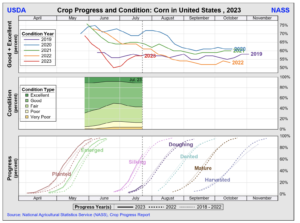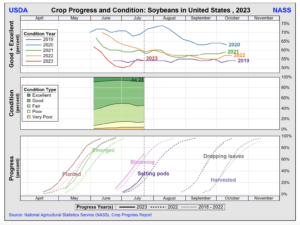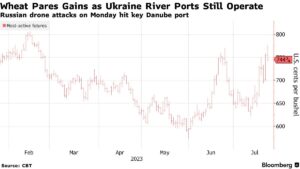Bloomberg's Leah Nylen reported Thursday that "a Colorado judge issued an order temporarily blocking the proposed $25 billion merger of Kroger Co. and Albertsons Cos., which has been challenged by…
U.S. Corn Condition Holds Steady, While Wheat Prices Move as Port of Reni Damage Assessed
Reuters writer Julie Ingwersen reported yesterday that, “Weekly condition ratings for the U.S. corn crop held steady in the past week while soybean and spring wheat crops deteriorated, U.S. government data showed on Monday, and ratings for all three crops fell short of trade expectations.

“The U.S. Department of Agriculture (USDA) rated 57% of the corn crop as good to excellent in its weekly crop progress report, unchanged from a week ago, while eleven analysts surveyed by Reuters on average had expected an improvement of 1 percentage point.”

Ingwersen explained that, “The USDA rated 54% of the soybean crop as good to excellent, down from 55% last week, and spring wheat ratings fell to 49% good-to-excellent, down from 51% previously. Analysts on average had expected no change in ratings for soybeans and spring wheat.
“The good-to-excellent ratings for both corn and soybeans were the lowest for this time of year since 2019, when excessive rains delayed planting and crop development, and the second-lowest since 2012, a historic drought year.”
Heading into this week's Midwest heat wave, I wanted to post the current accumulated stress degree day map.
— Eric Snodgrass (@snodgrss) July 24, 2023
Calculated by adding degrees above 86°F for each day.
Example: if today is 95°F, 9 SDDs are accumulated
>140 SDDs could result in corn yield loss
Data: PRISM April 1 pic.twitter.com/ZdgxRfOEsH
Meanwhile, Matthew Mpoke Bigg, Andrew Higgins, Andrés R. Martínez, Haley Willis and Tiffany May reported in today’s New York Times that, “Russia for the first time on Monday attacked a port on the Danube River in Ukraine, close to the Romanian border, Ukrainian and Romanian officials said, destroying a grain hangar in an escalation of its efforts to cripple Kyiv’s agriculture and risking a more direct confrontation with the United States and its European allies.
Russia again escalated its war on Ukrainians, their livelihoods, and global food security. While Russia's attacks on ports and grain storage strike another blow to Ukraine and the world's most vulnerable, we will continue supporting Ukraine in exporting food to those who need it. pic.twitter.com/gX1zEdYyxj
— Ambassador Bridget A. Brink (@USAmbKyiv) July 24, 2023
“The assault on the port in the town of Reni, across the river from Romania, a NATO member, targeted Kyiv’s alternative export routes for grain to reach world markets, days after Russia terminated a deal that had enabled Ukraine to ship its grain across the Black Sea. The attack is the closest Moscow has come to hitting the military alliance’s territory since Russia’s full-scale invasion of Ukraine last year.”
Spoke with Romanian Foreign Minister @Odobes1Luminita today. We affirmed our strong partnership and discussed shared support for Ukraine and global food security. We look forward to continued cooperation on Black Sea security.
— Secretary Antony Blinken (@SecBlinken) July 24, 2023
The Times article explained that, “Since the Kremlin pulled out of the Black Sea Grain Initiative last week, its forces have launched a barrage of attacks nearly every night on the city of Odesa — which is about 130 miles from Reni — and its Black Sea port, destroying grain stocks and infrastructure. Those attacks, along with Moscow’s warning that it would consider any ship approaching Ukraine’s Black Sea ports as potentially carrying military cargo, made Ukraine’s alternative grain routes more vital.”
.@StateDeptSpox condemns Russia’s attacks: Over the weekend, we saw appalling images of burning churches and flattened residential buildings. Today, Russia attacked grain warehouses on the Danube River. The consequences of Russia’s attacks on Ukraine have never been more clear. pic.twitter.com/vKQWmqP0Cy
— Department of State (@StateDept) July 24, 2023
And today, New York Times writers Jenny Gross and Patricia Cohen reported that, “For shipping companies looking for a way to bring Ukrainian grain to global markets, the options keep dwindling, escalating a trade crisis that is expected to add pressure on global food prices.”

Today’s article pointed out that, “‘It’s opening a new front in the targeting of Ukrainian grain exports,’ said Alexis Ellender, an analyst at Kpler, a commodities analytics firm, adding that the route had been considered safe because of its proximity to Romania, a NATO member.
“This will potentially close off that route,’ he said. It could also raise rates for shipping insurance and further cripple Ukraine’s ability to export grain.
Bloomberg writers Aine Quinn, Kateryna Choursina, and Daryna Krasnolutska reported yesterday that, “Wheat and corn prices surged after Russia attacked one of Ukraine’s biggest Danube river ports, ramping up the risks facing Kyiv’s last major grain export route and global food trade.”
#wheat, #corn- close pic.twitter.com/UXH3BhP6s4
— FarmPolicy (@FarmPolicy) July 24, 2023
However, Bloomberg writers Aine Quinn, and Lyubov Pronina reported today that, “Wheat futures pared some of their recent gains as it emerged that Russia has failed to severely damage a key port that is allowing Ukraine to export grains by river into neighboring countries.
“Russian drones attacked the port of Reni in the night leading to Monday, driving up grain prices as it threatened to choke off Ukraine’s last major hope of getting its crops to buyers.
But Reni was operating at maximum capacity on Tuesday, with seven ships due to enter, according to Romanian official Gabriel Covrig, who is responsible for ship piloting in the area.
“Chicago futures, the most traded global benchmark, retreated by as much as 2.2%. On Monday, they saw an 8.6% jump as traders tried to figure out the repercussions of damage to the river port. Shipments by river have become the last major route for grain to leave Ukraine after Russia exited a deal allowing passage through the Black Sea last week.”

A separate Bloomberg News article today reported that, “European Union agriculture ministers were discussing how to facilitate exports of Ukrainian grain during a meeting in Brussels on Tuesday as they continue to assess the damage from recent Russian strikes on Kyiv’s port infrastructure.”
A Reuters News article from yesterday reported that, “The Ukrainian grain traders union UGA said on Monday it had urged the European Union to increase the capacity of so-called solidarity lanes to help it export grain following the collapse of the Black Sea grain deal.”
In other developments, Reuters writer Naveen Thukral reported today that, “The European Union’s crop monitoring service on Monday further reduced its crop yield forecasts for this year’s harvest in the bloc, including grains, oilseeds and sugar beet, citing dry and hot weather conditions.
“Brazilian farmers had harvested 47% of the area planted for their second corn crop in the center-south region by the end of last Thursday, consultancy AgRural said, up 11 percentage points from the previous week.”





